Freeze vegetables quickly

Nofima scientists have investigated differences in nutritional content between frozen and fresh vegetables. There are little or no differences.
“Our results show that heat treatment has the greatest impact on the nutrient content, and affects especially the vitamin C content”, says scientist Sidsel Fiskaa Hagen. She has led the studies on health-related and sensory quality of vegetables in the NORFRYG project.
Texture analyses showed that frozen vegetables became softer than fresh ones after boiling, but the texture can also be affected by the cooking method. For example, boiled carrot was significantly softer than carrot that was pan-fried, steamed or heated in a microwave.
Frozen vegetables last long
Freezing is a good way to extend the shelf life of vegetables. If frozen industrially, they usually have a shelf life of up to 1.5 years. In order to preserve as much of the nutrients as possible, the vegetables should be frozen as quickly as possible.
“Rapid freezing gives the best results because vegetables contain a lot of water will expand and form ice crystals during freezing. The larger the ice crystals are allowed to grow, the more damage they do to the cells – and the greater the leakage of nutrients and the loss of texture”, explains Sidsel.
Vegetables should also be given a short heat treatment prior to freezing so as to inactivate enzymes that can cause poor taste and loss of nutrients during freezer storage.
Tested new freezing technology
The scientists have also tested a new technology; freezing under strong magnetic fields. They compared this technology with freezing in a factory tunnel freezer and in a regular freezer. The latter simulated the type of freezing that takes place in the homes of consumers.
“In our trials, freezing at the factory produced the best end results. ‘Home freezing’ came out worst. This is probably because freezing occurs much quicker in a factory tunnel freezer than in a regular freezer”, says Sidsel. The scientists found no effect of adding magnetic fields during freezing.
Research facts
The research has been carried out in the NORFRYG project. In addition to Nofima, Findus Norge AS, Brødrene Freberg DA, Hoppestad Gård and UCT Praha have participated.
The project is funded by the Research Council of Norway and participating companies. Sidsel Fiskaa Hagen has led the research on health-related and sensory quality.
Topics
Vegetables
Research facilities